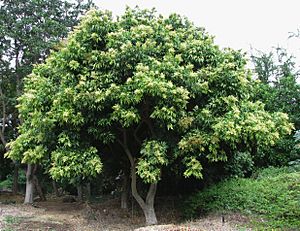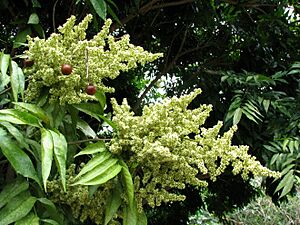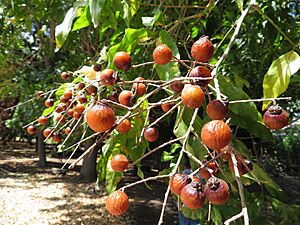Wingleaf soapberry facts for kids
Sapindus saponaria is a small to medium-sized deciduous tree that loses its leaves every year. It grows naturally in the Americas. People call it by many names, like wingleaf soapberry, western soapberry, jaboncillo, sulluku, and in Hawaiian, manele and a'e. The name of its genus, "Sapindus", comes from Latin words meaning "Indian soap". Its specific name, "saponaria", means "soapy", which is a big clue about one of its cool uses!
Quick facts for kids Wingleaf soapberry |
|
|---|---|
 |
|
| Sapindus saponaria tree. | |
| Scientific classification | |
| Genus: |
Sapindus
|
| Species: |
saponaria
|
| Varieties | |
|
S. s. var. drummondii |
|
Contents
What Does the Soapberry Tree Look Like?
The soapberry tree often grows in groups or thick patches. In some areas, these trees usually reach about 20 ft. (6.1 m) tall. However, if a tree grows by itself, it can become much taller, sometimes reaching up to 50 ft. (15.2 m). You can often find these trees at the start of prairie valleys, at the edges of forests, next to fields, or on rocky hills.
Leaves and Branches
The leaves of the soapberry tree are special. They grow in an alternating pattern along the branch and are made up of many smaller leaflets. These leaves are thick and feel a bit leathery. They are also deciduous, meaning they fall off each year. Each leaf can be quite long, from 8 in. (20 cm) to 15 in. (38 cm).
A single leaf has between 6 and 20 narrow, spear-shaped leaflets. These leaflets have smooth edges, pointed tips, and bases that are unevenly shaped like a wedge. They are usually 2 in. to 5 in. (5 cm to 13 cm) long.
The small branches of one type, drummondii, are gray-brown and have short, tan-colored hairs. The other type, saponaria, has gray branches that are smooth and hairless.
Flowers and Fruits
The soapberry tree produces many small, white flowers that grow in large, dense clusters at the ends of its branches. These flower clusters can be 6 in. to 10 in (15 cm to 20 cm) long.
After the flowers, the tree grows fruits in big, pyramid-shaped bunches. Each fruit is golden in color and about 1.2 in. to 1.4 in. (3 cm to 3.6 cm) wide. When the fruits are fully ripe, they become see-through and wrinkled. Inside each fruit is a single black seed, about .35 in (9 mm) across.
The fruits of the soapberry tree are very interesting because they contain a lot of a natural substance called saponin. This substance can make a soapy foam when mixed with water. Because of this, people in places like Mexico used to mash the fruits in water to wash clothes!
How People Use Soapberry Trees
The soapberry tree has several uses. The dark, round seeds are often used to make things like buttons and necklaces. The wood from the tree splits easily, which makes it good for weaving into baskets.
However, it's important to know that the fruits of one type of soapberry, S. drummondii, are poisonous. They can cause skin rashes if touched. Historically, these fruits were even used to make fish sleepy, making them easier to catch. The leaves of the tree might also be harmful to farm animals if they eat them. So, it's best to be careful around these plants.
Different Types of Soapberry Trees
There are two main types, or varieties, of Sapindus saponaria:
- Sapindus saponaria var. drummondii: This type is also known as the Western soapberry. It grows naturally from Arizona all the way to Louisiana in the southern United States, and north to Kansas and southwestern Missouri. You can also find it in parts of Mexico, including the states of Sonora, Chihuahua, and Coahuila.
- Sapindus saponaria var. saponaria: This type is called the Wingleaf soapberry. It mostly grows in southern Florida in the United States, and in a small area of coastal southeast Georgia. It is also found in the Caribbean, Central and South America, and on the island of Hawaiʻi.
Big and Famous Soapberry Trees
Some soapberry trees are so large and impressive that they are recognized as "national champions" in the United States!
- The biggest Sapindus saponaria var. drummondii in the U.S. is in southern Johnson County, Kansas. It stands 59 ft. (18 m) tall, has branches that spread 39 ft. (11.9 m) wide, and its trunk is 10 1/2 ft. (3.2 m) around.
- The biggest Sapindus saponaria var. saponaria in the U.S. is in Hawaii County, Hawaii. This tree is 71 ft. (21.6 m) tall, its crown spreads 68 ft. (20.7 m) wide, and its trunk measures 160.5 inches (408 cm) around.
Images for kids
See also
 In Spanish: Sapindus saponaria para niños
In Spanish: Sapindus saponaria para niños






